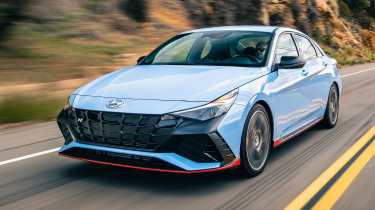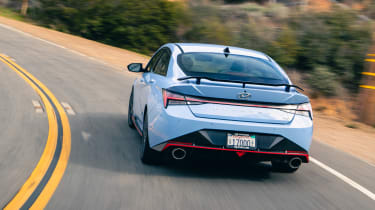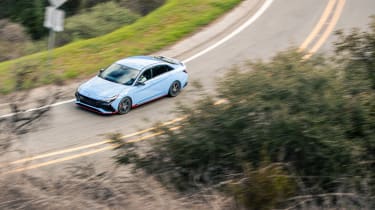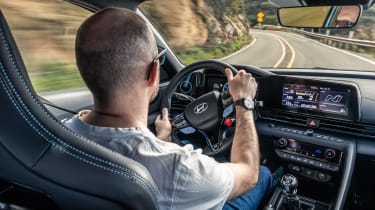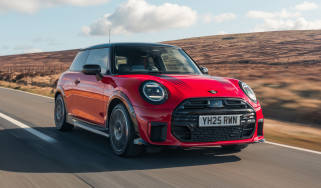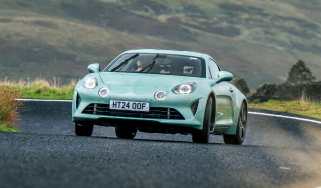Hyundai Elantra N 2022 review – a delicious piece of forbidden fruit
We love the i30 N hot hatch, so it’s little surprise that a saloon spin-off is similarly satisfying
Cars of this size and power are what evo was founded upon. A 276bhp sports saloon of identical dimensions was right at the heart of the attainable performance car world two decades ago, only then it represented something of a technological zenith. Wonderful though this Hyundai Elantra N may be, it’s not cut from the same homologation-special cloth as an Impreza or Lancer, however romantic their handful of parallels feel.
It's a punchy piece of design, though, headed up by Luc Donckerwolke of Lamborghini Gallardo fame. And with some inevitability it’s not headed to British shores. We’ve driven this latest N model - the sixth one launched worldwide – in the gleaming Californian sun, but it also pops up in plenty of other markets, and mostly those with a phobia to buying hatchbacks.
> Hyundai i20 N 2022 review – hot supermini zeros in on the Ford Fiesta ST
While Australia gets it badged as an i30 N Sedan, the truth is a little different. It's actually spun from a larger platform than the i30, and it’s pretty much a size bigger at 4.67 metres long (versus 4.34m), about half of which is accounted for in its wheelbase, which is 2.72 metres (rather than 2.65m). There’s more weight, too, albeit just 26 kilos at 1445kg. Impressive given the jump in size.
More reviews
Group tests
- Alpine A290 v Alpine A110 – how much DNA do they really share?
- Ariel Atom 4R v Caterham Seven ‘evo25’: power-to-weight heroes go head-to-head
- Caterham Super Seven 600 v Super Seven 2000
- Levante v T1
- Corvette Stingray v Porsche Cayman GTS v Audi R8 RWD
- Great Ferrari hypercars driven: 288 GTO, F40, F50 and Enzo head-to-head
- GMA T.50 v McLaren F1 – has the best car in the world been dethroned by its successor?
- Lamborghini Aventador Ultimae v Lamborghini Countach
- Lotus Emira v Morgan Plus Four – four-cylinder Brits go head-to-head
- Toyota GR86 v BBR Mazda MX-5: supercharged drop-top battles sports coupe
In-depth reviews
- Abarth 600e 2025 review – Italy gives the Alpine A290 something to worry about
- Alpine A110 2025 review – one of the all-time sports car greats will soon be gone
- Audi R8 (2015 - 2024) review – the ultimate soft-focus supercar
- Bentley Continental R Mulliner: review, history and specs
- BMW 5-series review – is this still Munich’s anchor model?
- BMW 1-series review – Munich’s Audi A3 rival gains focus
Long term tests
- Abarth 695C Turismo Fast Fleet test – 10,000 miles in the Italian hot hatch
- Alfa Romeo Giulia Veloce Fast Fleet test – 7000 miles in the sharp Italian saloon
- Alpina B10: end of term report
- Alpina B10
- Caterham Seven evo Edition revealed – bespoke 420R joins the Fast Fleet
- Ford Mustang GT
- Ford Mustang GT
- Land Rover Defender 110 Fast Fleet test – 9000 miles in the go-anywhere SUV
- Maserati Ghibli Trofeo Fast Fleet test – 4000 miles in the Ferrari-powered saloon
- Mitsubishi Evo MR 340
Review
- New Aston Martin DBS 770 Ultimate review – 759bhp super-GT driven
- New Bentley Batur 2023 review – can it possibly be worth £1.65m?
- 2023 Chevrolet Corvette C8 Z06 review – the American 911 GT3?
- Kia EV6 GT-Line S prototype review – the EV that shows how it’s done
- BBR Supercharged Mazda MX-5 (ND) 2023 review – tuned 250bhp roadster driven
- MG4 Trophy 2023 review
Reviews
- Abarth 695 75 Anniversario edition 2024 review – a fitting send-off for Abarth’s hot supermini?
- Abarth 500e 2023 review
- AC Cobra 378 Superblower MkIV 2021 review – another V8 Cobra, but with a GM heart this time
- Acura Integra Type S 2024 review – a Honda Civic Type R with added restraint
- Alfa Romeo 33 Stradale 2025 review – a rare Italian jewel beyond compare
- Alfa Romeo Giulia 2025 review – get one while you still can
- Alfa Romeo SZ: history, review and specs of an icon
You’ll be delighted to know it’s been through N’s typically tough development programme – split between Namyang and the Nürburgring, with Albert Biermann wielding the golden clipboard at the end of it all – but the Elantra has had its own, more comfort-biased set-up applied with final sign off on roads and proving grounds in the US.
It uses the same 276bhp, 289lb ft 2.0-litre turbo four as other Ns – namely the i30, Kona and Veloster – driving the front wheels via a six-speed manual or eight-speed DCT transmission. A limited-slip differential is standard fit, as is the almost bafflingly large selection of driving modes and settings we know from European Ns.
There’s new stuff, too. It’s been engineered with the same depth as its range-mates, some of the work helping account for its modest weight jump over the smaller i30 N. The chassis has extra weld points, there’s a bright red strut brace to boost body rigidity (by 29 per cent) and this is the first Hyundai to use an Integrated Drive Axle (IDA), which nabs tech learned from the company’s WRC programme to integrate the drive shaft, wheel hub and bearing into one unit, saving 1.7kg. Maybe there’s some homologation genes after all.
You’re also looking at the widest tyres yet fitted to an N car – Michelin Pilot Sport 4Ss measuring 245/35/19, up 10mm on an i30 N on 19s – and today they’re working with exceedingly favourable mid-twenties temperatures, too. Fitting N’s wonderfully hugging sports bucket seats actually opens up another 50mm of legroom in the back, too. It’s a proper family car, in other words…
Not least because it’s immediately a bit softer around the edges than the Ns we get on British shores. It’s deliberate – Hyundai describes this as an ‘ambidextrous’ performance car, one just a bit more mature than the littler Ns it’s sold alongside.
Much of its behaviour is familiar. The engine rasps into life with the shame hard-edged four-cylinder soundtrack as an i30, and its steering has the same eagerness. It’s hard to comment on just how much the suspension has changed because rural roads in the US are so much better layered than ours. Whether it’s better tarmac, the Elantra’s softer touch or a combination of the two, here’s an N where you’ll finally use the stiffest notch of the adaptive damping on road and genuinely relish it.
I soon find I’ve programmed it into my chosen settings for the pale blue N button on the steering wheel. Like the i20 N, there are two of these, so you can have two ‘individual’ setups depending on just how rambunctious you’re feeling. You’ll want the exhaust sound in its mid mode or lower either way, though, to avoid some annoying piped-in acoustics.
It’s about the only unnatural, annoying thing this car does. This may be a more mature N, but it’s still one you’ll attack a good stretch of road in with a big old grin on your face. It won’t wiggle its hips with the ease of an i30, and it’ll be the front tyres squealing before the rears, but this is still a deliciously assertive front-wheel-drive car. Perhaps the bumpier, damper tarmac of a British B-road would unhook the rear axle a little more than a California canyon on a mid-20s day can. The sad thing is we’ll likely never find out.
Some words of praise for the manual, too, or more specifically Hyundai’s decision to offer it alongside an auto. It’s a setup that needs just an inch more throttle and a few more revs to pull away cleanly than a mainstream manual – a stick-shift Golf GTI is easier-going than this – but it simply means you’re alert and focused from the very first interaction you and the powertrain have. Tauntingly cheap gas prices mean the US doesn’t seem unduly worried about the efficiency gains of stop/start systems, either, so the engine never thrums automatically back into life to save any stalling blushes like it might back home. The DCT is probably a more natural fit with the Elantra’s grown-up swagger, but could you resist the option of three pedals while it’s still there?
Price and rivals
The manual also happens to be cheaper, starting at $32,945 where the DCT is another $1,500. Yes, that does convert into a number that’s bafflingly small – a starting price of little more than £24,000 seems barely comprehensible to us Brits. The Elantra is a bargain even in its own showroom, though, priced below the smaller Veloster N while packing the same performance and frankly staggering ten-year powertrain warranty. Given the treatment this engine encourages, that’s a ballsy move by Hyundai.
The UK already has the i30 N and its quirky Fastback variant, meaning the Elantra won’t come here. Which is a shame given it’s sold in other right-hand-drive markets. While $30,000 sports sedans in the States are numerous – it’s a country where you can still buy a Subaru WRX, and there’s a new Acura Integra coming – we’d only really be able to compare this Hyundai to the likes of the Audi S3 and BMW M235i Gran Coupe on our chillier shores. They’re fairly anodyne badging exercises that I suspect it’d shrug aside with extreme nonchalance.
Hyundai Elantra N specs
| Engine | In-line four-cylinder, 1998cc, turbocharged |
| Power | 276bhp @ 5500-6000rpm |
| Torque | 289lb ft @ 2100 to 4700rpm |
| Weight | 1445kg |
| 0-62mph | 5.3sec |
| Top speed | 155mph |
